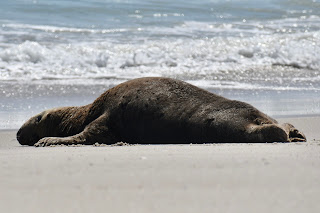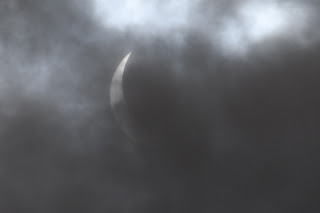4/8/24- Pre-Eclipse Birding at Island Beach SP - Iceland Gull, Redhead and Gray Seals
Yesterday I had the day to myself and it was the first nice spring day we’ve had around here in awhile so I headed out to my favorite spot, Island Beach State Park. The much hyped solar eclipse was expected in New Jersey shortly after 2 p.m.. Since we were outside of the path of totality, I felt the event would not have much of an affect on our wildlife. I never obtained a pair of viewing glasses, so I spent the day walking the trails and driving the beach. I could always catch the eclipse highlights on the news.
It turned out to be a good day at the park, my most productive birding day of the year, logging 70 bird species. I saw a few other interesting creatures too: my first red admiral butterfly of the season, a large black racer snake and two large gray seals resting on the beach.
Two gray seals basking on the beach, 4/8/24. © S. Weiss
Young gray seal basking on beach, 3/22/24. © S. Weiss
Along my drive on the beach, I came upon a young Iceland gull standing near the water. eBird flagged it as rare, so I took a few photos for documentation. Bird-wise, the rest of the beach drive did not produce any rare or new year birds, though I did tally three dozen lesser black-backed gulls and eight piping plovers. Down near the inlet, I did have an American kestrel dart past me. Unfortunately, they are becoming scarcer at the park. The two seals were basking on the sand, a few miles apart from each other.
Iceland gull. © S. Weiss
After the beach I took a walk down the Spizzle Creek trail with the intent of finding a female common merganser that a friend of mine had recently seen there. Common mergansers are not common at the park as they prefer freshwater habitat. Casual eBird reporters often mistakenly identify them as such from the more common, red-breasted mergansers. Where the trail splits is a pond-like enclosure of the marsh where ducks often gather. I did a quick scan of the pond and only saw some red-breasted mergansers, bufflehead and some greater scaup. I did not pick out the common merganser, but another duck caught my eyes. A drake redhead was associating with the scaup. Redhead is a rare bird for the park and, according to eBird, rare for the county at this time of year. On another, and more thorough, scan of the mergansers I finally found the slightly larger common mixed in with its red-breasted cousins. Near the bird blind hut, I was scanning the northern side of the marsh and noticed a few ducks fly in and disappear in the reeds. I was able to find them again when they moved through a slight clearing and recognized them as northern pintails. Like the redhead, eBird considered them to be rare for this time of the year. Also in the marsh were my fist of the year tricolored herons. A pair of American wigeons and a few green-winged teals rounded out my list for the day.
American wigeon. © S. Weiss
Before I left the park the eclipse had begun. Cloud cover had moved through, somewhat reducing the full spectacle of the event. But for me, the cloud cover provided a safe screen to see the eclipse and take a few photos of it. This likely will be the last full eclipse in the east of my lifetime.
Solar eclipse, 4/8/24. © S. Weiss










Comments
Post a Comment